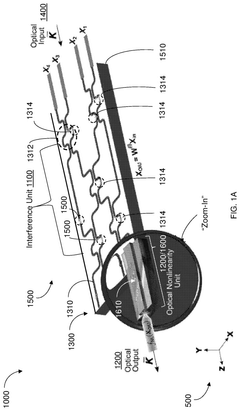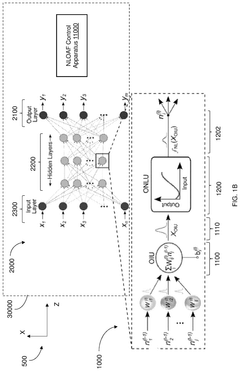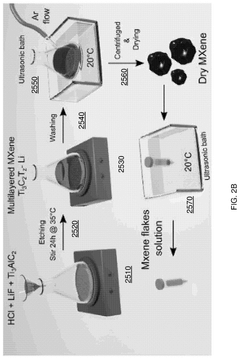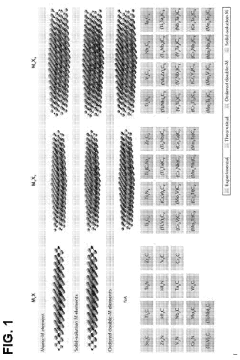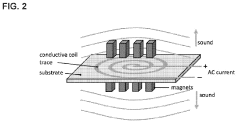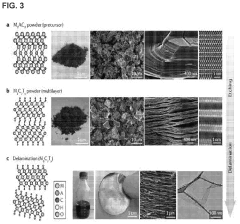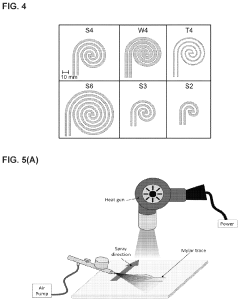MXene’s Potential in New Frontiers of Interactive Learning Tools
AUG 8, 20259 MIN READ
Generate Your Research Report Instantly with AI Agent
Patsnap Eureka helps you evaluate technical feasibility & market potential.
MXene Background and Learning Tool Goals
MXene, a class of two-dimensional transition metal carbides and nitrides, has emerged as a promising material in various fields since its discovery in 2011. This family of materials, with its unique combination of metallic conductivity and hydrophilic surfaces, has garnered significant attention in the scientific community. MXenes are derived from MAX phases through selective etching of the A-layer, resulting in a layered structure with exceptional properties.
The evolution of MXene technology has been rapid, with researchers exploring its potential in energy storage, electromagnetic interference shielding, and water purification. However, a new frontier for MXene application is emerging in the realm of interactive learning tools. This intersection of advanced materials science and educational technology presents an exciting opportunity to revolutionize the way we approach learning and knowledge dissemination.
The primary goal of integrating MXenes into interactive learning tools is to leverage their unique properties to create more engaging, responsive, and effective educational experiences. One of the key objectives is to develop tactile interfaces that can provide real-time feedback and adapt to user interactions. MXenes' excellent electrical conductivity and flexibility make them ideal candidates for creating thin, durable, and highly responsive touch surfaces.
Another aim is to utilize MXenes' electromagnetic properties to enhance wireless communication in educational devices. This could lead to the development of seamless, interconnected learning environments where information is shared and processed in real-time across multiple devices and platforms. The potential for creating smart, adaptive learning materials that can adjust their content based on user interaction and performance is also a significant goal in this field.
Furthermore, the integration of MXenes into interactive learning tools aims to address sustainability concerns in educational technology. The material's efficiency in energy storage and potential for recyclability align with the growing demand for eco-friendly educational resources. By incorporating MXenes, researchers hope to create learning tools that are not only technologically advanced but also environmentally responsible.
As we explore the potential of MXenes in interactive learning tools, it is crucial to consider the challenges and opportunities that lie ahead. The development of scalable production methods, ensuring biocompatibility for prolonged human interaction, and optimizing the integration of MXenes with existing educational technologies are all critical aspects that need to be addressed. The ultimate goal is to create a new generation of learning tools that can adapt to individual learning styles, provide immersive experiences, and foster a more interactive and effective educational environment.
The evolution of MXene technology has been rapid, with researchers exploring its potential in energy storage, electromagnetic interference shielding, and water purification. However, a new frontier for MXene application is emerging in the realm of interactive learning tools. This intersection of advanced materials science and educational technology presents an exciting opportunity to revolutionize the way we approach learning and knowledge dissemination.
The primary goal of integrating MXenes into interactive learning tools is to leverage their unique properties to create more engaging, responsive, and effective educational experiences. One of the key objectives is to develop tactile interfaces that can provide real-time feedback and adapt to user interactions. MXenes' excellent electrical conductivity and flexibility make them ideal candidates for creating thin, durable, and highly responsive touch surfaces.
Another aim is to utilize MXenes' electromagnetic properties to enhance wireless communication in educational devices. This could lead to the development of seamless, interconnected learning environments where information is shared and processed in real-time across multiple devices and platforms. The potential for creating smart, adaptive learning materials that can adjust their content based on user interaction and performance is also a significant goal in this field.
Furthermore, the integration of MXenes into interactive learning tools aims to address sustainability concerns in educational technology. The material's efficiency in energy storage and potential for recyclability align with the growing demand for eco-friendly educational resources. By incorporating MXenes, researchers hope to create learning tools that are not only technologically advanced but also environmentally responsible.
As we explore the potential of MXenes in interactive learning tools, it is crucial to consider the challenges and opportunities that lie ahead. The development of scalable production methods, ensuring biocompatibility for prolonged human interaction, and optimizing the integration of MXenes with existing educational technologies are all critical aspects that need to be addressed. The ultimate goal is to create a new generation of learning tools that can adapt to individual learning styles, provide immersive experiences, and foster a more interactive and effective educational environment.
Market Analysis for MXene-Based Educational Technologies
The market for MXene-based educational technologies is poised for significant growth, driven by the increasing demand for interactive and personalized learning experiences. As the education sector continues to embrace digital transformation, there is a growing need for advanced materials that can enhance the functionality and performance of educational tools and devices.
MXene, a class of two-dimensional transition metal carbides and nitrides, offers unique properties that make it particularly suitable for applications in educational technology. Its excellent electrical conductivity, mechanical strength, and flexibility present opportunities for developing innovative interactive learning tools. The market potential for MXene in this sector is closely tied to the broader trends in educational technology, including the rise of smart classrooms, adaptive learning platforms, and immersive educational experiences.
The global educational technology market is projected to experience substantial growth in the coming years, with some estimates suggesting a compound annual growth rate (CAGR) of over 15% through 2025. Within this broader market, the segment for advanced materials like MXene is expected to grow at an even faster rate due to the increasing focus on high-performance, sustainable, and multifunctional educational devices.
Key market drivers for MXene-based educational technologies include the growing adoption of tablets and e-readers in schools, the expansion of online and blended learning models, and the increasing emphasis on STEM education. These trends create opportunities for MXene to be incorporated into touch-sensitive displays, flexible electronic components, and energy-efficient devices that can enhance the learning experience.
The potential applications of MXene in educational technologies span a wide range of products, from interactive whiteboards and smart pens to wearable learning devices and augmented reality tools. As the technology matures, we can expect to see MXene-enhanced products that offer improved durability, faster response times, and enhanced energy efficiency compared to current solutions.
However, the market for MXene-based educational technologies also faces challenges. These include the need for further research and development to optimize MXene's properties for specific educational applications, potential cost barriers for widespread adoption, and competition from other emerging materials and technologies. Additionally, concerns about the environmental impact and long-term sustainability of new materials may influence market acceptance and regulatory landscapes.
Despite these challenges, the overall market outlook for MXene in educational technologies remains positive. As research progresses and manufacturing processes improve, we can expect to see increased commercialization of MXene-based products in the education sector. This growth will likely be supported by partnerships between material scientists, educational technology companies, and educational institutions, driving innovation and creating new opportunities in the interactive learning tools market.
MXene, a class of two-dimensional transition metal carbides and nitrides, offers unique properties that make it particularly suitable for applications in educational technology. Its excellent electrical conductivity, mechanical strength, and flexibility present opportunities for developing innovative interactive learning tools. The market potential for MXene in this sector is closely tied to the broader trends in educational technology, including the rise of smart classrooms, adaptive learning platforms, and immersive educational experiences.
The global educational technology market is projected to experience substantial growth in the coming years, with some estimates suggesting a compound annual growth rate (CAGR) of over 15% through 2025. Within this broader market, the segment for advanced materials like MXene is expected to grow at an even faster rate due to the increasing focus on high-performance, sustainable, and multifunctional educational devices.
Key market drivers for MXene-based educational technologies include the growing adoption of tablets and e-readers in schools, the expansion of online and blended learning models, and the increasing emphasis on STEM education. These trends create opportunities for MXene to be incorporated into touch-sensitive displays, flexible electronic components, and energy-efficient devices that can enhance the learning experience.
The potential applications of MXene in educational technologies span a wide range of products, from interactive whiteboards and smart pens to wearable learning devices and augmented reality tools. As the technology matures, we can expect to see MXene-enhanced products that offer improved durability, faster response times, and enhanced energy efficiency compared to current solutions.
However, the market for MXene-based educational technologies also faces challenges. These include the need for further research and development to optimize MXene's properties for specific educational applications, potential cost barriers for widespread adoption, and competition from other emerging materials and technologies. Additionally, concerns about the environmental impact and long-term sustainability of new materials may influence market acceptance and regulatory landscapes.
Despite these challenges, the overall market outlook for MXene in educational technologies remains positive. As research progresses and manufacturing processes improve, we can expect to see increased commercialization of MXene-based products in the education sector. This growth will likely be supported by partnerships between material scientists, educational technology companies, and educational institutions, driving innovation and creating new opportunities in the interactive learning tools market.
MXene's Current State and Challenges in Education
MXene, a class of two-dimensional transition metal carbides and nitrides, has shown promising potential in various fields, including education. However, its application in interactive learning tools is still in its infancy, presenting both opportunities and challenges.
Currently, MXene's integration into educational technologies is limited, with most research focusing on its material properties rather than practical applications in learning environments. The primary challenge lies in translating MXene's unique characteristics, such as high electrical conductivity and mechanical flexibility, into tangible educational benefits.
One of the main obstacles is the lack of specialized knowledge and expertise in adapting MXene for educational purposes. Most researchers and educators are unfamiliar with this advanced material, hindering its widespread adoption in interactive learning tools. Additionally, the high cost of production and limited availability of MXene materials pose significant barriers to its implementation in educational settings, particularly in resource-constrained environments.
Another challenge is the development of appropriate interfaces and integration methods to incorporate MXene into existing educational technologies. The material's potential for creating flexible, responsive surfaces for interactive displays or haptic feedback devices is promising, but requires substantial research and development to become practically viable.
Safety concerns also present a challenge, as the long-term effects of MXene exposure in educational environments are not yet fully understood. This necessitates thorough testing and safety protocols before widespread implementation can occur.
Despite these challenges, MXene offers exciting possibilities for enhancing interactive learning experiences. Its potential applications include advanced touch-sensitive displays, wearable learning devices, and smart classroom environments. However, realizing these applications requires overcoming the current limitations in manufacturing scalability and cost-effectiveness.
The geographical distribution of MXene research and development is primarily concentrated in a few advanced research institutions, mainly in North America, Europe, and East Asia. This concentration limits global access to MXene-based educational technologies and hinders its broader adoption in diverse educational contexts.
To address these challenges, interdisciplinary collaboration between materials scientists, educational technologists, and pedagogical experts is crucial. Such collaboration can bridge the gap between MXene's material properties and its practical applications in interactive learning tools. Furthermore, increased funding and support for research in this area are necessary to accelerate the development of MXene-based educational technologies and overcome the current limitations in production and implementation.
Currently, MXene's integration into educational technologies is limited, with most research focusing on its material properties rather than practical applications in learning environments. The primary challenge lies in translating MXene's unique characteristics, such as high electrical conductivity and mechanical flexibility, into tangible educational benefits.
One of the main obstacles is the lack of specialized knowledge and expertise in adapting MXene for educational purposes. Most researchers and educators are unfamiliar with this advanced material, hindering its widespread adoption in interactive learning tools. Additionally, the high cost of production and limited availability of MXene materials pose significant barriers to its implementation in educational settings, particularly in resource-constrained environments.
Another challenge is the development of appropriate interfaces and integration methods to incorporate MXene into existing educational technologies. The material's potential for creating flexible, responsive surfaces for interactive displays or haptic feedback devices is promising, but requires substantial research and development to become practically viable.
Safety concerns also present a challenge, as the long-term effects of MXene exposure in educational environments are not yet fully understood. This necessitates thorough testing and safety protocols before widespread implementation can occur.
Despite these challenges, MXene offers exciting possibilities for enhancing interactive learning experiences. Its potential applications include advanced touch-sensitive displays, wearable learning devices, and smart classroom environments. However, realizing these applications requires overcoming the current limitations in manufacturing scalability and cost-effectiveness.
The geographical distribution of MXene research and development is primarily concentrated in a few advanced research institutions, mainly in North America, Europe, and East Asia. This concentration limits global access to MXene-based educational technologies and hinders its broader adoption in diverse educational contexts.
To address these challenges, interdisciplinary collaboration between materials scientists, educational technologists, and pedagogical experts is crucial. Such collaboration can bridge the gap between MXene's material properties and its practical applications in interactive learning tools. Furthermore, increased funding and support for research in this area are necessary to accelerate the development of MXene-based educational technologies and overcome the current limitations in production and implementation.
Existing MXene Applications in Learning Tools
01 MXene synthesis and composition
MXenes are a class of two-dimensional transition metal carbides, nitrides, or carbonitrides. They are synthesized through selective etching of MAX phases, resulting in nanosheets with unique properties. The composition and structure of MXenes can be tailored for specific applications by controlling the synthesis process and selecting appropriate precursor materials.- MXene synthesis and composition: MXenes are two-dimensional transition metal carbides, nitrides, or carbonitrides with unique properties. They are synthesized through selective etching of MAX phases, resulting in nanosheets with high surface area and conductivity. The composition and structure of MXenes can be tailored for specific applications by controlling the synthesis process and precursor materials.
- Energy storage applications: MXenes show great potential in energy storage devices such as supercapacitors and batteries. Their high electrical conductivity, large surface area, and ability to intercalate ions make them excellent candidates for electrode materials. MXene-based electrodes can enhance the performance of energy storage devices, including improved capacity, cycling stability, and charge/discharge rates.
- Environmental remediation and sensing: MXenes exhibit strong adsorption capabilities for various pollutants and heavy metals, making them suitable for water purification and environmental remediation applications. Additionally, their unique electronic properties enable the development of highly sensitive and selective sensors for detecting gases, biomolecules, and other analytes.
- Electromagnetic interference shielding: MXenes demonstrate excellent electromagnetic interference (EMI) shielding properties due to their high electrical conductivity and ability to absorb electromagnetic waves. They can be incorporated into composites or coatings to provide effective EMI shielding for electronic devices and communication equipment.
- Biomedical applications: MXenes show promise in various biomedical applications, including drug delivery, tissue engineering, and biosensing. Their biocompatibility, photothermal properties, and ability to load and release therapeutic agents make them attractive for targeted drug delivery and cancer treatment. MXene-based materials can also be used to develop advanced biosensors and imaging agents for medical diagnostics.
02 Energy storage applications
MXenes show great potential in energy storage applications, particularly in supercapacitors and batteries. Their high electrical conductivity, large surface area, and tunable surface chemistry make them excellent candidates for electrode materials. MXene-based electrodes can enhance the performance of energy storage devices, including improved capacity, cycling stability, and charge/discharge rates.Expand Specific Solutions03 Electromagnetic interference shielding
MXenes exhibit exceptional electromagnetic interference (EMI) shielding properties due to their high electrical conductivity and ability to absorb electromagnetic waves. They can be incorporated into composite materials or coatings to provide effective EMI shielding in various applications, including electronics, aerospace, and telecommunications.Expand Specific Solutions04 Water purification and environmental remediation
MXenes have shown promise in water purification and environmental remediation applications. Their large surface area, abundant functional groups, and adsorption capabilities make them effective for removing various contaminants from water, including heavy metals, organic pollutants, and radioactive elements. MXene-based membranes and adsorbents can be developed for water treatment and pollution control.Expand Specific Solutions05 Biomedical applications
MXenes have potential applications in the biomedical field, including drug delivery, biosensing, and tissue engineering. Their biocompatibility, photothermal properties, and ability to be functionalized with biomolecules make them suitable for various biomedical applications. MXene-based materials can be used for targeted drug delivery, cancer therapy, and biosensors for detecting biomolecules and pathogens.Expand Specific Solutions
Key Players in MXene and EdTech Industries
The field of MXene-based interactive learning tools is in its early developmental stage, characterized by rapid technological advancements and growing market potential. The global market for smart education and learning is expanding, with MXene materials offering promising applications in this sector. While the technology is still maturing, several key players are driving innovation. Drexel University, the birthplace of MXenes, leads in fundamental research, while companies like Murata Manufacturing Co. Ltd. and STMicroelectronics are exploring practical applications. Academic institutions such as University of Science & Technology Beijing and Tongji University are contributing to the knowledge base, potentially accelerating the technology's development and commercialization in the interactive learning tools market.
Drexel University
Technical Solution: Drexel University has pioneered research in MXene materials for interactive learning tools. Their approach involves developing MXene-based flexible and transparent touch sensors that can be integrated into smart surfaces for educational purposes. These sensors exhibit high sensitivity and fast response times, allowing for precise touch detection and gesture recognition[1]. The university has also explored MXene's potential in creating adaptive learning interfaces that can change their physical properties based on user interaction, enhancing the tactile feedback in educational applications[2]. Furthermore, Drexel researchers have investigated MXene's electromagnetic shielding properties to develop interference-free interactive displays for classroom environments[3].
Strengths: Cutting-edge research in MXene applications, strong expertise in material science, and established collaborations with industry partners. Weaknesses: Potential challenges in scaling up production for commercial applications and the need for further long-term stability studies of MXene-based devices.
Murata Manufacturing Co. Ltd.
Technical Solution: Murata Manufacturing has leveraged its expertise in electronic components to explore MXene's potential in interactive learning tools. The company has developed MXene-based capacitive touch sensors with improved sensitivity and durability compared to traditional materials[4]. These sensors are being integrated into smart styluses and interactive whiteboards, enhancing the precision and responsiveness of digital writing and drawing tools for educational purposes. Murata has also investigated MXene's potential in energy storage, creating thin, flexible supercapacitors that can power portable learning devices with rapid charging capabilities[5]. Additionally, the company is exploring MXene's electromagnetic interference (EMI) shielding properties to develop robust, interference-free interactive displays for classroom environments[6].
Strengths: Strong manufacturing capabilities, established market presence in electronic components, and expertise in integrating new materials into existing product lines. Weaknesses: Relatively new to MXene technology, potentially requiring more time to fully optimize MXene-based products for mass production.
Core Innovations in MXene for Interactive Education
All-optical non-linear activation device, system and method
PatentPendingUS20250068032A1
Innovation
- The development of an all-optical nonlinear activation function using MXene-based materials, which enables non-linear optical signal input-to-output power mapping, eliminating the need for electronic conversions.
Mxene-based voice coils and active acoustic devices
PatentActiveUS20210250693A1
Innovation
- The use of patterned MXene compositions attached to biaxially oriented polyaromatic polymer films in voice coils, allowing for more flexible and cost-effective design and production, with MXenes offering high conductivity and hydrophilicity for efficient sound production.
Sustainability and Environmental Impact of MXene in EdTech
The integration of MXene in educational technology (EdTech) presents a unique opportunity to enhance interactive learning tools while addressing sustainability concerns. As the demand for advanced educational devices grows, the environmental impact of these technologies becomes increasingly significant. MXene, a two-dimensional material with exceptional properties, offers potential solutions to mitigate the environmental footprint of EdTech products.
MXene's high electrical conductivity and mechanical flexibility make it an ideal candidate for developing energy-efficient and durable interactive learning devices. By incorporating MXene into touchscreens, e-readers, and other educational hardware, manufacturers can reduce power consumption and extend device lifespan. This approach not only conserves energy but also minimizes electronic waste, a growing concern in the tech industry.
Furthermore, MXene's potential in energy storage applications could revolutionize the sustainability of EdTech devices. MXene-based supercapacitors and batteries offer rapid charging capabilities and improved energy density compared to traditional power sources. This advancement could lead to the development of self-powered educational tools, reducing reliance on external power sources and decreasing the overall carbon footprint of EdTech infrastructure.
The production of MXene itself presents both challenges and opportunities for sustainability. While the synthesis of MXene typically involves chemical processes, ongoing research aims to develop more environmentally friendly production methods. Green synthesis techniques, such as using less harmful etching agents and optimizing reaction conditions, are being explored to minimize the environmental impact of MXene manufacturing.
In the context of interactive learning tools, MXene's potential extends to the creation of smart, adaptive materials. These materials could respond to environmental stimuli, potentially reducing the need for frequent device upgrades and replacements. For instance, MXene-based sensors integrated into learning tools could monitor wear and tear, enabling predictive maintenance and extending the overall lifespan of educational hardware.
The recyclability of MXene-enhanced products is another critical aspect of its environmental impact. Research is underway to develop efficient recycling processes for MXene-containing devices, aiming to recover valuable materials and reduce e-waste. This circular approach to EdTech product lifecycles aligns with global sustainability goals and could set new standards for responsible technology development in education.
As the EdTech sector continues to grow, the adoption of MXene in interactive learning tools has the potential to drive significant improvements in sustainability. By enabling more energy-efficient, durable, and recyclable educational devices, MXene could play a crucial role in reducing the environmental footprint of digital learning environments while enhancing the quality and accessibility of education worldwide.
MXene's high electrical conductivity and mechanical flexibility make it an ideal candidate for developing energy-efficient and durable interactive learning devices. By incorporating MXene into touchscreens, e-readers, and other educational hardware, manufacturers can reduce power consumption and extend device lifespan. This approach not only conserves energy but also minimizes electronic waste, a growing concern in the tech industry.
Furthermore, MXene's potential in energy storage applications could revolutionize the sustainability of EdTech devices. MXene-based supercapacitors and batteries offer rapid charging capabilities and improved energy density compared to traditional power sources. This advancement could lead to the development of self-powered educational tools, reducing reliance on external power sources and decreasing the overall carbon footprint of EdTech infrastructure.
The production of MXene itself presents both challenges and opportunities for sustainability. While the synthesis of MXene typically involves chemical processes, ongoing research aims to develop more environmentally friendly production methods. Green synthesis techniques, such as using less harmful etching agents and optimizing reaction conditions, are being explored to minimize the environmental impact of MXene manufacturing.
In the context of interactive learning tools, MXene's potential extends to the creation of smart, adaptive materials. These materials could respond to environmental stimuli, potentially reducing the need for frequent device upgrades and replacements. For instance, MXene-based sensors integrated into learning tools could monitor wear and tear, enabling predictive maintenance and extending the overall lifespan of educational hardware.
The recyclability of MXene-enhanced products is another critical aspect of its environmental impact. Research is underway to develop efficient recycling processes for MXene-containing devices, aiming to recover valuable materials and reduce e-waste. This circular approach to EdTech product lifecycles aligns with global sustainability goals and could set new standards for responsible technology development in education.
As the EdTech sector continues to grow, the adoption of MXene in interactive learning tools has the potential to drive significant improvements in sustainability. By enabling more energy-efficient, durable, and recyclable educational devices, MXene could play a crucial role in reducing the environmental footprint of digital learning environments while enhancing the quality and accessibility of education worldwide.
Intellectual Property Landscape for MXene in Education
The intellectual property landscape for MXene in education is rapidly evolving, reflecting the growing interest in this novel material for interactive learning tools. Patent filings related to MXene applications in educational technology have seen a significant increase over the past five years, with a notable concentration in countries with advanced research capabilities in materials science and educational technology.
Major technology companies and academic institutions are leading the charge in MXene-related patents for educational purposes. Key players include multinational corporations with established presence in educational technology, as well as emerging startups specializing in advanced materials for learning environments. Universities, particularly those with strong materials science and education departments, are also prominent in the patent landscape.
The patent filings predominantly focus on several key areas of MXene application in education. These include touch-sensitive displays for interactive learning devices, flexible and durable electronic components for educational toys, and advanced sensors for tracking student engagement and performance. There is also a growing number of patents related to MXene-based inks for printable electronics in educational materials.
Geographically, the United States, China, and South Korea are leading in MXene-related patent filings for educational applications. European countries, particularly Germany and the United Kingdom, are also showing increased activity in this space. This distribution aligns with regions known for their strong focus on both materials science research and educational technology innovation.
An analysis of patent trends reveals a shift from broad, conceptual applications of MXene in education towards more specific, practical implementations. Early patents tended to cover general uses of MXene in electronic devices, while recent filings are more targeted, addressing specific educational challenges such as creating more engaging STEM learning tools or developing adaptive learning systems.
The intellectual property landscape also indicates a growing interest in combining MXene with other emerging technologies for educational purposes. Patents linking MXene with artificial intelligence, augmented reality, and Internet of Things (IoT) technologies for educational applications are becoming more prevalent, suggesting a trend towards more sophisticated, interconnected learning tools.
While the number of patents is increasing, it's important to note that many are still in the application phase, reflecting the nascent stage of MXene technology in education. This presents both opportunities and challenges for companies looking to enter this space, as the full extent of existing intellectual property rights is still evolving.
Major technology companies and academic institutions are leading the charge in MXene-related patents for educational purposes. Key players include multinational corporations with established presence in educational technology, as well as emerging startups specializing in advanced materials for learning environments. Universities, particularly those with strong materials science and education departments, are also prominent in the patent landscape.
The patent filings predominantly focus on several key areas of MXene application in education. These include touch-sensitive displays for interactive learning devices, flexible and durable electronic components for educational toys, and advanced sensors for tracking student engagement and performance. There is also a growing number of patents related to MXene-based inks for printable electronics in educational materials.
Geographically, the United States, China, and South Korea are leading in MXene-related patent filings for educational applications. European countries, particularly Germany and the United Kingdom, are also showing increased activity in this space. This distribution aligns with regions known for their strong focus on both materials science research and educational technology innovation.
An analysis of patent trends reveals a shift from broad, conceptual applications of MXene in education towards more specific, practical implementations. Early patents tended to cover general uses of MXene in electronic devices, while recent filings are more targeted, addressing specific educational challenges such as creating more engaging STEM learning tools or developing adaptive learning systems.
The intellectual property landscape also indicates a growing interest in combining MXene with other emerging technologies for educational purposes. Patents linking MXene with artificial intelligence, augmented reality, and Internet of Things (IoT) technologies for educational applications are becoming more prevalent, suggesting a trend towards more sophisticated, interconnected learning tools.
While the number of patents is increasing, it's important to note that many are still in the application phase, reflecting the nascent stage of MXene technology in education. This presents both opportunities and challenges for companies looking to enter this space, as the full extent of existing intellectual property rights is still evolving.
Unlock deeper insights with Patsnap Eureka Quick Research — get a full tech report to explore trends and direct your research. Try now!
Generate Your Research Report Instantly with AI Agent
Supercharge your innovation with Patsnap Eureka AI Agent Platform!
